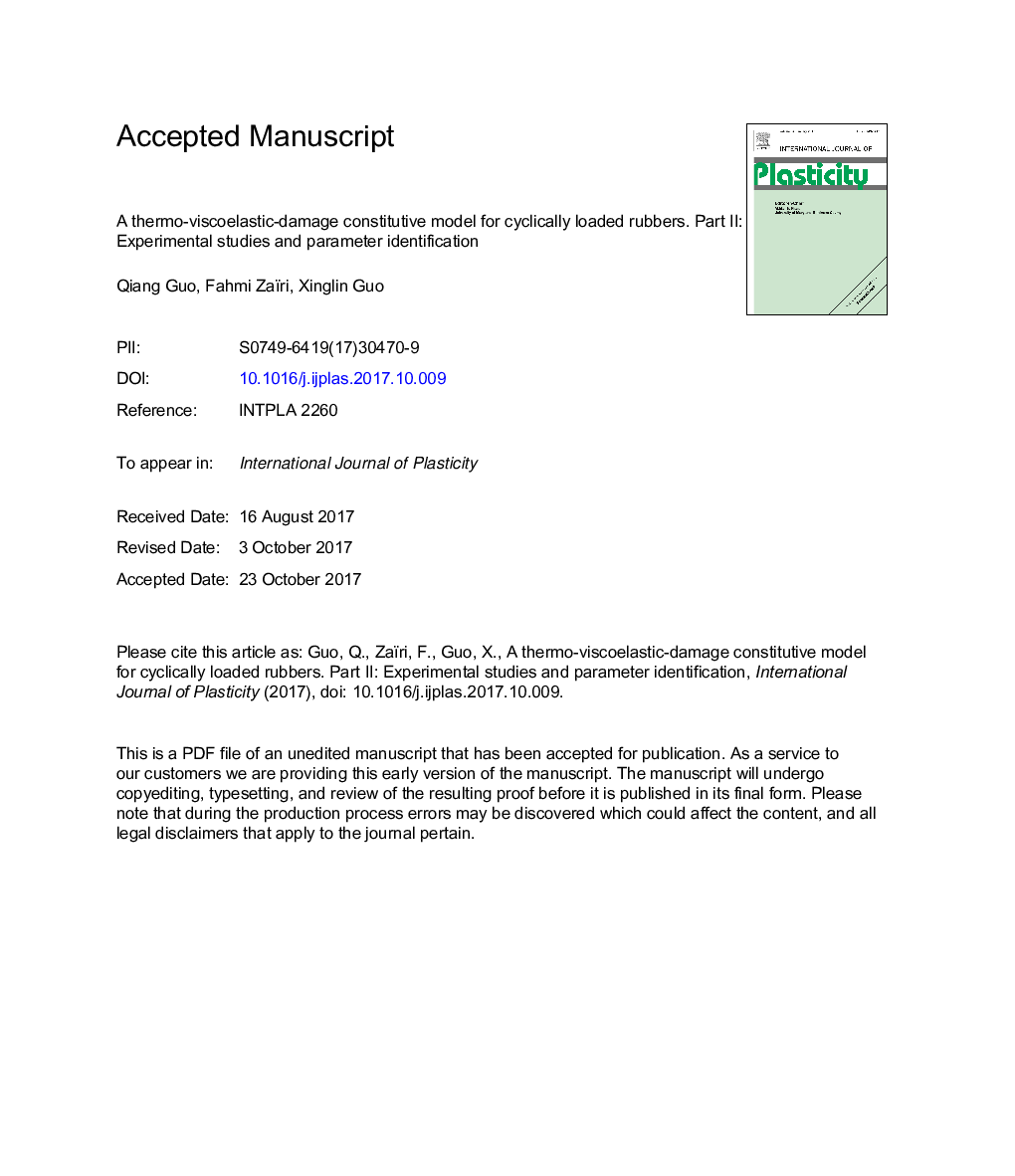| کد مقاله | کد نشریه | سال انتشار | مقاله انگلیسی | نسخه تمام متن |
|---|---|---|---|---|
| 7174860 | 1465572 | 2018 | 25 صفحه PDF | دانلود رایگان |
عنوان انگلیسی مقاله ISI
A thermo-viscoelastic-damage constitutive model for cyclically loaded rubbers. Part II: Experimental studies and parameter identification
ترجمه فارسی عنوان
مدل سازنده ی آسیب دیدگی گرماسوزوالاستیک برای رول های چرخه ای لود شده. قسمت دوم: مطالعات تجربی و شناسایی پارامترها
دانلود مقاله + سفارش ترجمه
دانلود مقاله ISI انگلیسی
رایگان برای ایرانیان
کلمات کلیدی
خستگی، گرمایش تابشی، رب کربن سیاه، قبل از کشش سطح،
ترجمه چکیده
در دمای اتاق، سطوح مختلف قبل از کشیدگی مورد آزمایش قرار گرفته است. لاستیک استایرن بوتادین دارای سایزهای مختلف حاوی مقادیر مختلف کربن سیاه است. مشاهدات تجربی، به ویژه در ارتباط با پاسخهای چند مرحله ای قطع شده توسط دوره های آرام سازی و گرمای تابشی، بینش ارزشمندی را نسبت به اثرات قبل از کشش و پرکننده بر مکانیسم های فیزیکی زیرزمینی این سیستم مواد پرکننده لاستیکی ارائه می دهند. با توجه به نقش فعال پرکننده های کربن سیاه در ماتریس لاستیک بر روی پدیده های غیر قابل انعطاف از طریق برهمکنش های میکروسکوپی محلی، تئوری سازنده در بخش اول این اثر اصلاح شده است تا به طور صریح اثرات پرکننده را ترکیب کند. یک روش شناسایی قطعی برای استخراج پارامترهای مدل قابل تفسیر از ماتریس لاستیکی پیشنهاد شده است. خواص شبکه کامل و زنجیرهای آزاد شده (درهم و غش شده) با استفاده از روش الحاقی تقویت شده با استفاده از داده های آرامشده استرس به عنوان یک تابع از محتوای پرکننده و پاسخ سیکلی مکانیکی وابسته به تاریخ در بالاترین محتوای پرکننده. خواص ماتریس لاستیکی شناسایی به شبیه سازی عناصر محدود به عنوان پایه های ورودی معرفی می شوند و همان شرایط مرزی ترمو مکانیکی مربوط به آزمایش های تجربی شبیه سازی می شوند. توانایی مدل پیشنهادی پیشنهاد شده برای پیش بینی پاسخ ترمو مکانیکی تحت دو بلوک بارگیری سیکل با سطوح مختلف قبل از کشش با مقایسه با آزمایش ها تایید می شود. مدل سازنده قادر است با موفقیت اثرات قبل از کشش و پرکننده را در کاهش استرس ایجاد شده توسط خستگی، هیسترزیزه و تغییر دما تغییر دهد.
موضوعات مرتبط
مهندسی و علوم پایه
سایر رشته های مهندسی
مهندسی مکانیک
چکیده انگلیسی
Cyclically loaded styrene-butadiene rubber containing different amounts of carbon-black is experimentally examined under different pre-stretch levels at room temperature. The experimental observations, especially related to both the multi-step cyclic response interrupted by relaxation periods and the dissipative heating, provide valuable insights into the pre-stretch and filler effects on the underlying physical mechanisms of this rubber-filler material system. According to the active role of carbon-black fillers dispersed in the rubber matrix on the inelastic phenomena via the local microscopic interactions, the constitutive theory formulated in the Part I of this work is modified in order to incorporate explicitly the filler effects. A deterministic identification procedure is proposed to extract the physically interpretable model parameters of the rubber matrix. The properties of the perfect network and the superimposed (entangled and non-entangled) free chains are identified via an amplification-inspired procedure using, respectively, the relaxed-stress data as a function of the filler content and the history-dependent mechanical cyclic response at the highest filler content. The identified rubber matrix properties are introduced into the finite element simulations as input constants and the same thermo-mechanical boundary conditions regarding the experimental tests are simulated. The capabilities of the proposed constitutive model to predict the thermo-mechanical response under two cyclic loading blocks with different pre-stretch levels are verified by comparisons with experiments. The constitutive model is found able to successfully capture the pre-stretch and filler effects on the fatigue-induced stress-softening, the hysteresis and the change in temperature.
ناشر
Database: Elsevier - ScienceDirect (ساینس دایرکت)
Journal: International Journal of Plasticity - Volume 101, February 2018, Pages 58-73
Journal: International Journal of Plasticity - Volume 101, February 2018, Pages 58-73
نویسندگان
Qiang Guo, Fahmi Zaïri, Xinglin Guo,
